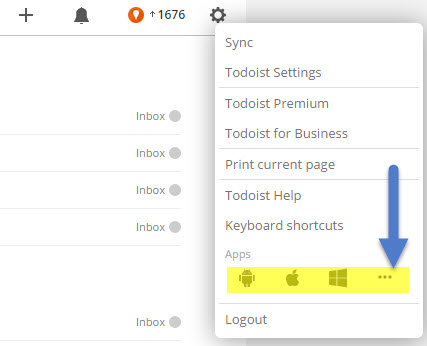Get your time back. 10 minutes today can save 1 hour tomorrow & the next day
Today’s world is full of interruptions. Do you know what interruptions cost you?
23 minutes & 15 seconds to be exact.
This is according to a study done on managers, financial analysts and software developers.
So how often are you interrupted each day? It could be every 10 minutes if you’re like those in the study.
Do you get pulled out of focus by emails? Do you struggle to keep a “Getting Things Done” level todo list? Have you found a todo system to handle and simplify your life or is it too cumbersome to work effectively?
Who doesn’t struggle with these issues these days? What I learned in the past few months of focusing on improving my workday is that there are finally effective solutions to these problems.
Bonus: Comments are below, share your experience and ask questions
How I changed my daily task management to give me +1 hour extra every day.
I realized a few months ago that I was not working as efficiently as I needed to be. I noticed the time I spent actually focusing on tasks throughout the day had decreased. So I’ve spent the past three months or so really focusing on finding ways to improve my workflow.
The most important problem I identified was the amount of time I spent in email. Essentially, I was getting locked in my inbox, handling to-do items one by one while inside email. Worse, I was regularly finding focus was lost with each new inbound email. I knew I needed to reduce the interruptions email was creating.
As a broader issue, I also found I had too many places where tasks lived. We use One Note to track individual, department and client meetings. We used Basecamp and have transitioned to Jira for task management of client and internal projects. I used my inbox to store emails with outstanding tasks. I spent a lot of time just trying to find where to go for my next to-do items.
This wasn’t very effective.
Starting with a system
Getting things done provides great context around how to manage your to-do lists and recommends using paper systems to manage them. This simply won’t work for me. The time spent investing in transitioning to-do items onto paper was not one that would provide efficiency or effectiveness for someone in a digital space. So what digital options are there? Tons, as it turns out.
It’s actually alarming how many software companies have tried to produce task management systems. More astonishingly, most of them really don’t make it as easy as it should be in today’s increasingly inter-connected world. Sure, I can access my notes from anywhere, updating or completing tasks on the go or at my desk. But that’s so 2005. What today’s task management systems need is a deeper level of integration with every possible platform you might be using.
The most obvious integration requirement is email. Put simply: You need to be able to quickly create a task from an email and be able to reference back to that as the originating source for follow-up and next steps. I tried out about 10 different task management/note taking systems with various degrees of failure and limited success.
Enter Todoist (free /w paid option)
Todoist allows me to create a task, that contains a direct link back to that email, from just about any email program you might be using today. This is the only task management system I’ve tried that meets this requirement seamlessly.
Install the browser extension, the desktop app and the mobile app. Todoist makes it easy to find these applications in the settings menu:

Once integrated, you can create tasks from within Gmail while you’re processing your inbox. This get’s you out of email quickly by providing a simple solution to export tasks from email into a trusted system.
Develop a schedule
The first step to I took after getting Todoist up and running was to optimize my day, establishing a schedule for processing email. Starting with perhaps 30 minutes a day. Or 30 minutes twice a day. Start small, you’ll be more likely to succeed at achieving a less lengthy time investment. I eventually had to adjust after about a week to 3 thirty minute sessions per day. But I typically receive 100-200 emails a day. Mileage will vary.
Start processing emails only during this time window you’ve setup. Your goal is to process emails into todos or archive them if there’s no work needed.
Respond to emails that take 60 seconds or less to write a response. Create a task, delegate and/or Archive all others.
Gmail’s archive function stores the email and keeps it searchable. I archive every email each time I process my inbox. Yep – get to ZERO every time.
Note: If you have thousands of old emails, select the check all button then look for this message at the top:
![]()
Archiving may seem scary, but all emails are stored just as they were before. You can access them in the left navigation under ‘All Mail’ very easily. And again, they’re still included in your search results. It’s just a method for organizing the mess and lowering your stress levels. If you’re like me, getting to inbox zero is an uplifting and motivating occasion each time I do it.
What about emails that need follow up in a day, a week, a month?
So, if you are really trying to keep a zero inbox and keep todos out of email, what about those pesky follow up scenarios?
I sent an email but want to follow up if no one responds.
I want to remember to respond to this email tomorrow morning.
I want to remember to respond next month.
Todoist could work, but it’s a bit cumbersome for this simple scenario. I’d still be able to create a future todo, but it’s possible it won’t actually be a todo like if I only need to respond if no one replies to my email.
Enter Boomerang (free /w paid option)
Boomerang allows you to easily get reminders within your email based on simple and common scenarios like those above. It’s amazingly easy to use and, of course, it integrates with Gmail. If you’re on another system, check for similar plugins for your current system. There is likely to be some options.
Integrate todoist with your other tools
Integration with other services is something you should require from most of your tools these days. What happens when that one tool you love doesn’t directly integrate with Todoist or any other tool? Connect them anyway!
Most tools on the Internet will integrate with IFTTT or Zapier.
Bonus: If you’ve never used these or similar services, here’s an example of how flexible these systems can be.
Use these to bridge gaps between services that don’t directly integrate with Todoist. For example:
Calendar reminders as Todos:
Many people find it’s effective to use a calendar to plan their day. They can set due dates for todos and block out time slots in Google Calendar using Zapier to integrate their calendar and Todoist tasks.
I’ve found that using this strategy, and making small adjustments where I find efficiencies, has doubled the number of tasks I’m completing each day. That translates to somewhere between 1-3 hours a day worth of productivity. Everything is in one place. I move all my tasks into todoist and organize and schedule them. I don’t need to watch my inbox all day, I don’t need to jump all over the place to find out what to work on next.
Sublime.
Do you have a better system? Other ideas? Questions? Comment below, we’d love to hear from you!
Get any nuggets of useful tips in this article? Thank you for sharing this with your favorite social network.
Tags In
Chase
Recent Posts
Recent Comments
- Shannon Thammasiene on How to Create a Successful Blog
- Sarah on How to Create a Successful Blog
- How to Create a Successful Blog on 5 Free Keyword Research Tools that will Rock your Socks
- Olivier Hamphrey on This Week In Social Media
- Richard Dickerson on Use Email to Sell without Selling




